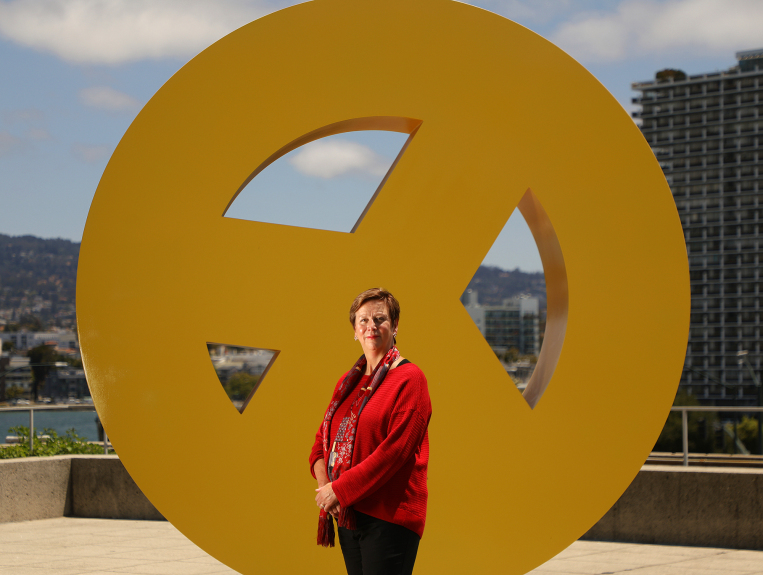How Bay Area museums are bouncing back after COVID

In February of 2020, just before the world shut down, the Oakland Museum of California broke ground on a long-awaited renovation. The project and the pandemic kept the museum closed to the public for more than a year.
So its reopening this summer was an exciting moment for a remade Oakland institution — but one that comes as cultural venues enter an uncertain future.
The Oakland Museum was among many such institutions that had to slash costs and cut staff positions to weather the pandemic. And while government aid has helped museums get by, many fear a quick recovery may not be in the cards.
Oakland Museum Director and CEO Lori Fogarty discussed how her organization navigated COVID, and what it expects as the pandemic wanes.
This conversation has been edited for clarity and length.
Q: What has reopening been like for the museum?
A: It’s fantastic to be open again. That’s our purpose: To be a place for people to come, and to come together.
It was great to see people back on-site. Just standing at the front entry, greeting people as they came in — people were happy, they were telling us they were thrilled to be back. It was really a very joyous, celebratory environment.
Q: COVID was also a reinvention for the museum physically. What will visitors notice is different?
A: When we opened, it wasn’t just opening — it was really unveiling all of the new facilities.
(The project) was a complete renovation of the garden space itself, and then a new entry on the corner that faces Lake Merritt. Lake Merritt is such a hub of activity, so we’re sort of throwing open the gates and extending our welcome mat to the community with that strong connection to the lake.
It was a very deliberate, intentional effort to ‘Break the box.’ Our building and our campus, they were revolutionary representations of landscape and building design from the mid-century, brutalist architecture. It’s incredible, (but) we appeared a little bit fortress-like from the exterior.
This was a bold gesture to say, “We are open, we welcome you, we are part of the neighborhood.”
Q: How have museums been doing financially through the pandemic?
A: The arts is one of the hardest-hit sectors. National studies have shown that the cultural sector — both museums and especially performing arts organizations, which are going to be even slower to reopen — have just been devastated.
The good news is that the federal government responded to that urgency. Many museums did receive (Paycheck Protection Program) loans. We just received a Shuttered Venue Operators Grant, which was really important for us.
At most museums, all earned revenue (which includes ticket sales and revenue from gift shops, cafes and events, among other sources) was lost for months, at least in the Bay Area and California. There were museums in other parts of the country that were open in June of last year, but even then, at such reduced capacity that their earned revenue was really hard hit.
Q: Does the future look better for museums as things reopen?
A: Well, what I think is important to note is that this is not back to normal (and) business as usual as we reopen. We are still anticipating that earned revenue will be down significantly — that we won’t see the numbers in attendance that we typically would, at least for the coming year.
Many arts organizations receive funding through a hotel tax, and that tax is way, way down. Those losses in revenue will continue this year.
We’ve planned for that in our budget, so we are smaller in our budget and our staffing than we were pre-COVID. But we are also not in fiscal crisis. It’s just that we’re going to have to be leaner and meaner for at least another year.
Q: Do you think people are eager to go back to gathering spaces and the kind of big events the Oakland Museum is known for?
A: I think we will have a return to those large events, and I just think it’s going to happen gradually. Many people are ready to rush back into crowds, other people are more cautious. So I think we will see a slower return.
We’re seeing this fall as the slow ramp-up. But I would hope that by next spring or summer we will be back to full gear.
Q: Have you learned anything new from the pandemic about what museums mean to communities and how you can serve the public?
A: I think we’ve all learned how much people really appreciate being with other people and having these gathering places. Seeing real objects, seeing artwork in person — I think people hunger for that.
At the same time I think we’ve all learned there is a real opportunity around virtual programming. We’ll all be ready to get off the Zoom calls and Zoom webinars and all of that, (but) we’ve seen that it does broaden our audience.
It gives us a chance to reach people who we wouldn’t otherwise reach, so I think we’ve learned that virtual programming will be part of our future. For all museums, I think they’re seeing there are some real gains for that — and there’s no substitute for the in-person experience.

